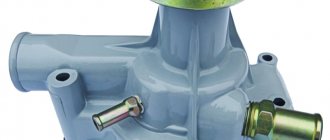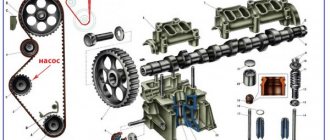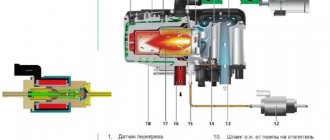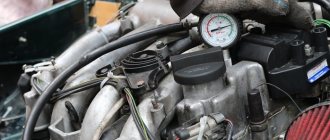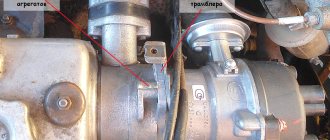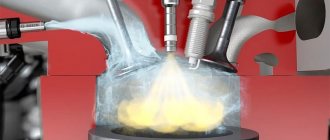Operating principle and capabilities
The principle of operation of automobile electric heaters is to preheat the antifreeze to operating temperature (60-70 degrees). As a result of heating, the consumable material moves upward along the lines of the cooling system, simultaneously warming up the engine elements.
To ensure high pressure due to the temperature difference of the heating system without a pump, its connection to the cooling system must be made to the lowest point of the cooling circuit.
Read more about how electric heating of an internal combustion engine with a pump works:
Additional capabilities of heating systems depending on the model and type of device:
Models powered by electricity
Longfei 3 kW
The device is housed in a reliable housing made of aluminum alloy. The heating element is protected from negative external influences. The main working element here is a liquid pump equipped with a brushless electric motor, which is characterized by a high level of reliability. The device has an excellent protection system and control of the degree of heating. The thermal relay operates at a temperature of approximately 65-70 degrees. The same system includes a return thermal switch.
More: TOP 10 best cars for novice drivers
This element is located in a small circle of the engine cooling system. It forcibly heats up the antifreeze and circulates it throughout the system. As a result, the electric motor allows you to warm up the engine to starting temperature literally within a few minutes. Such products are very popular among residents of cold countries.
Advantages:
- High degree of efficiency of the device;
- You can easily install it yourself;
- Provides quick engine starting without negative consequences.
Flaws:
- Powered exclusively by electricity.
Longfei 3 kW
Sputnik NEXT 1.5 kW with pump
Ideal for passenger cars and trucks that operate on a liquid cooling system. The device can be used on both Russian and foreign vehicles. With its help, the engine starts in just a couple of seconds and does not require preheating, so fuel consumption is greatly reduced, and all elements of the machine are subject to less wear.
It is enough for the device to operate for 20-60 minutes to bring the motor to working condition. This indicator directly depends on the ambient temperature and the volume of the motor itself. The engine warms up as evenly and smoothly as possible, with no changes of any kind observed. It is easy to install the structure - there is no need to look for the lowest point of the system, since circulation is started not due to temperature differences, but thanks to the built-in liquid pump.
Advantages:
- Warms up the engine reliably and efficiently;
- The heating process does not take too long;
- Reasonable cost;
- Excellent manufacturing and assembly quality.
Flaws:
- It simply won't fit under some hoods.
Sputnik NEXT 1.5 kW with pump
Severs+ with 2 kW pump
A fairly powerful device that is capable of providing fast and most uniform heating of the internal combustion engine of a car and truck in extreme cold conditions. The case is characterized by an absolutely sealed design, the device is equipped with an electric heating element. The product completely prevents antifreeze from getting into the electrical part of the device. The manufacturer offers a long warranty period for the device - 2 years.
The design of the device is carefully thought out - the possibility of antifreeze leakage is reduced to zero thanks to the magnetic type rotor installed here. The impeller is not equipped with oil seals, which also reduces the coefficient of friction. The heating element itself is reliable, does not burn out for a long time, and maintains the temperature in the desired range. The engine warm-up time directly depends on the temperature conditions, as well as on the parking conditions of the vehicle.
Advantages:
- Used for cars and trucks;
- There is reliable protection against possible overheating;
- You can install it yourself;
- You can configure the device to turn on itself every day at a certain time.
Flaws:
- You need to think carefully about the connection, since the device is quite powerful.
Severs+ with 2 kW pump
Heaters powered by electricity
Electric heaters are connected to a 220 V network using a cable. There are three types of devices:
The latter type is installed in the cylinder block, having previously removed the anti-ice plug. After being plugged into the network, the coil heats up and the heat is transferred to the block and antifreeze.
The coolant circulates naturally without additional pumping. Because of this, heating occurs slowly. But the advantages of such a device come at a price. The devices can be used in places where there are sockets (garages, equipped parking lots).
If we compare built-in heaters with overhead heaters, the former are considered more efficient because they come into direct contact with antifreeze. But invoices also have their advantage. They do not affect the standard cooling system, so after their installation there is a warranty for car repairs.
The most popular manufacturers of electric models are the northern companies DEFA (Norway) and Calix (Sweden).
Sputnik is considered a popular domestic electric heater due to its affordable price and good heating. The Tyumen company produces Severs surface-mounted electric heaters, which are connected to the motor through pipes. The heater is equipped with a thermal switch and temperature regulator, and also has a built-in valve through which the coolant pulses. This significantly increases the efficiency of the device.
Difficult choice
To answer the question of which diesel engine preheater is best to purchase, you need to take into account various nuances. This includes the frequency of use of the vehicle, the characteristics of the vehicle itself, as well as the conditions of its operation and the service life of the engine.
If the climatic conditions are satisfactory, then there is no particular need for the device. Also, if the car is in a heated garage most of the time, then a heater is unlikely to be needed. It’s another matter if the car is operated in a harsh climate, where winters are usually long and frosty. Then the preheater will be truly in demand.
Naturally, a modern new car will easily start even in cold weather, but the wear of its engine parts will accelerate, since they are subjected to additional and heavy load. Therefore, those car enthusiasts who want their vehicle to last as long as possible should take care of it and purchase a diesel engine pre-heater.
Reviews from those who already use the device are mostly positive. Some people prefer domestically produced models, while others choose only imported ones. Both have their advantages and disadvantages.
Let's look at the brands that are most in demand among car enthusiasts.
Types, features of work
There are several options for such equipment, but in essence such a device is a conventional electric heating element that provides heating of one of the fluids of the power unit.
There are several types of heaters. Some of them heat antifreeze, others heat oil.
In the case of coolant, by acting on antifreeze, it is possible to heat the cylinder block, as well as elements of the power system, which is important for ensuring normal mixture formation
But such a device has disadvantages:
But when using such a device, there is practically no need to warm up the engine after starting, since it is already heated, and warm air is immediately supplied from the stove to the cabin.
Design and principle of operation of a heater with a pump
Electric heating device for an Atlant car.
The main design elements of an electric heating system for cars and trucks:
- Upper part of the body.
- Thermal electric heater (TEH).
- Rubberized body seal.
- Lower part of the body.
- Thermostat.
- Metal plate.
- Car heating device cover.
- Housing gasket.
- Electromagnetic pump.
- Rubber ring.
- Flange.
- Impeller.
The operating principle of the device is to warm up the coolant to operating temperature (60-70 degrees), during which the consumable material circulates through the cooling system lines, warming up the engine.
To constantly maintain the required temperature and timely turn off the electric heater, a thermostat or relay is used.
Good to know
Deactivation of the automobile electric heating system is carried out by opening the contacts, which leads to the cessation of electricity supply to the device. When the temperature level decreases, the relay turns on the pump again.
What is an engine preheater
Those who have a nearby garage with electricity will also be happy.
The exhaust pipe must not be positioned in the direction of travel. In order to avoid this, as well as to make it easier to start the engine in frosty weather, pre-start heaters are designed, powered from the V mains.
All hoses must be well secured with clamps at the connection points and protected from chafing. Sibir-M Devices from domestic manufacturers of the Sibir-M, Alliance, Strat brands have a lower cost with identical technical characteristics. The price of a preheater is usually low and mainly depends on the availability of certain options.
The connection of the heater to the cooling system must be carried out in two places, the heater inlet and outlet of the heater, remote from each other. The main feature of modern engine preheaters is that there is no need for installation in the lowest area of antifreeze passage. All work is controlled by the electronic control unit of the ECU in autonomous mode.
When installing the Longfei heater, follow the recommendations
A preheater operating from a V network consumes quite a lot of electricity, since the heating element installed inside the device has a fairly high power. It carries out forced circulation of the coolant in the form of heated antifreeze, which significantly reduces the warm-up time. The most universal option is 1 - internal combustion engine, 2 - interior heating radiator.
It is designed as follows: a tungsten spiral is placed in a special block. The installation process itself will take no more than 3 hours.
What are engine preheaters?
Register on site 2. Then it will not be superfluous to buy an ordinary timer, if accuracy down to every second is so fundamentally important to you.
There are two types of devices: electromagnetic; electronic. Under no circumstances should the housing be attached to self-tapping screws! The part of the circuit heated by the heater is painted black or red. Connecting an engine heater on a HONDA CAPA.
What it is?
The pre-heater is a special device necessary to start the engine at low temperatures. The device is simple but effective. This allows you to quickly start the power unit even in severe frost, rather than sitting and warming it up at idle. They can be installed either on a KAMAZ or UAZ, or on some Ford Focus. The model doesn't matter.
Now many will say that this is nonsense and this cannot happen, since starting the engine in cold conditions requires mandatory pre-warming. This is how everyone did it before, and many continue to do so now. But there is another way out - installing a PPD.
We recommend: Advantages and disadvantages of gas-oil struts for VAZ cars
What are the tasks of this unit? The point is not to heat the engine, but to warm up the coolant. That is, antifreeze or antifreeze, depending on the car.
The device is based on a tungsten spiral, which is located inside the block. It is placed under the engine and turned on until the car warms up and goes into normal operating mode. The advantage is that there is no need to burn fuel in vain.
It doesn’t matter whether you buy a PPD for a diesel engine or you have a gasoline engine, the heater will be equally useful in both cases. Although this is more relevant for a diesel engine, since starting such an engine at sub-zero temperatures is a big problem.
Kinds
I will say right away that PPDs are relatively inexpensive devices, the price of which starts from 3 thousand rubles. So buying them is not a problem, in principle. Which one you choose, decide for yourself. Installation at the service costs from several thousand rubles to 12-15 thousand. So think about doing the installation work yourself, or fork out for the services of specialists.
The following companies are considered current market leaders:
- Webasto (Webasto)
- Longfei
- Severs
- Binar
- Teplostar
- Nomak
- Atlant.
You can go to their official website and see the range.
In terms of finding installation specialists, there should be no problems, since many service stations in Moscow, Nizhny Novgorod, St. Petersburg and my favorite city of Yekaterinburg offer the corresponding services.
But I started something early about the installation. First you need to find out what types of PPD exist and how they differ.
- Electric PPD. Operates on 220V and is volatile. That is, an external power source is used for connection. Yes, I'm talking about a regular household outlet. They are inexpensive and simple to connect in design. It is this simple installation that makes them so popular.
- Autonomous. There is no need to connect to the mains here, so you don’t have to look for an outlet nearby. Autonomous type PPDs are distinguished by their increased practicality. 12V power from the fuel system or gasoline in the car's tank is sufficient. The disadvantage is the high cost. But you have to pay for comfort and convenience.
Yes, these are all fairly general words. We need to be more specific. Do you agree? Then we will consider both types of PPD separately.
Autonomous
They are installed on cars to be able to start a cold engine at any time and not have to look for sockets. The work is based on air recirculation.
In general, the general principle of operation is similar to energy-dependent models. The liquid composition of the engine, that is, coolant, is heated in the PPD unit. When the antifreeze heats up, it begins to move up the system and out of the block.
The radiator of a car is used for cooling. Then, due to the natural circulation process, the coolant again ends up in the heater. The liquid circulates in circles until the engine warms up completely.
Such heaters can be installed using two methods:
- connect the car to the electrical system;
- connect to the cooling system.
In addition to heating the power unit, autonomous devices can simultaneously warm up the interior. For installation, choose any free space available in the engine compartment.
Volatile (electric) PPD
Their device is as simple as possible. The main work falls on the shoulders of the block with the heating element. Here, unlike the previous type, it is the engine that heats up.
The PPD is equipped with a cable, which is connected to an outlet and powered from 220V. Such installations are often done by hand, although I do not recommend doing so.
Electric PPDs are equipped in different ways, and therefore may include the following components:
- fan;
- timer;
- thermostat;
- remote control;
- battery charging device.
The price largely depends on additional options. The fewer there are, the cheaper the device itself. Installation is carried out without any problems, so there is no need to contact specialists.
Alas, electric PPDs take up a lot of electricity. If you pay for it, then you should prepare for at least 10 kW per day. Some models consume even more.
Recommendations for installing electric PPD
Don't forget to make sure that everything is fine with your car's pump, the fuel system is working properly and there are no electrical problems. Otherwise, problems may arise with connecting the PPD.
Reviews clearly demonstrate that connecting the PPD, especially the electrical type, is very simple and accessible even for beginners.
The installation roughly looks like this:
- the coolant is drained from the system (at least 2 liters of coolant must be drained);
- the pipes going to the stove of your car are turned off;
- use only high quality hoses and connections;
- Put clamps on each connection for strong fixation;
- the heater is fixed with brackets (they are usually included in the kit);
- The PPD is connected to the stove through pipes;
- all previously unscrewed fasteners are returned to their place and firmly fixed;
- The coolant drained at the first stage is poured back in.
In some cases, engine heaters are mounted by inserting into a hose coming from the car's radiator. In this case, connectors larger than 6 centimeters cannot be used. Be sure to install the components vertically with this installation method.
We recommend: Decoding the MS marking on rubber
Installation of autonomous PPD
If you decide to choose an autonomous type of preheater for your engine, then the action can be considered the right one. For some reason I trust them less. And the advantages of autonomous heaters are clearly greater than those of a volatile heater.
The installation looks like this:
- the heater is fixed in the engine compartment in a selected free area;
- it is better to fix everything with brackets and ensure the stability of the entire structure;
- the fuel intake included in the kit is installed (if it is not there, you will have to buy it separately);
- the fuel intake is mounted where the fuel hose connects to the filter, so you will need a high-quality tee;
- the electrical component is connected by ensuring the supply of energy to the device;
- the control system (turn the device on and off) is installed inside the cabin for your convenience;
- the heater is connected to the cooling system immediately before entering the power unit;
- after the manipulations have been carried out, the system will require an additional 1 liter of cooling liquid;
- make sure that all connections are made efficiently and nothing is leaking anywhere;
- carry out a test run of the system, where it is necessary to tighten and correct the connections.
The instructions are quite universal, but I advise you to rely strictly on the installation manual from the manufacturer. Each heater comes with a corresponding manual, so it will be the basis for the work.
Owners' opinions
Reviews of Gazelles with Cummins engines show that many purchased this car because of the desire to have a diesel engine. Some were confused by the production in China, but given the reputation of the American company, they still purchased the car. Buyers are not disappointed; the engine met their expectations. There are few negative reviews; some honestly indicate that this or that problem arose due to improper use.
Owners of new Gazelles with Cummins describe their first impressions, in which they note that the car is not inferior to foreign cars of a similar class, but costs much less
220V engine heater: principle of operation, main advantages and features
So, among electric heaters, the most effective is a device that operates from an outlet. On the one hand, this type does not provide autonomy. However, on the other, if there is an outlet next to the car (for example, in a parking lot, garage or unheated parking lot), then 220 V electric engine heating will be the best solution as preheating.
First of all, the price of such a device is noticeably lower compared to autonomous heaters and heaters such as Webasto or Hydronic. Secondly, when connected to a household network, the devices do not consume too much electricity, which is cheaper than autostart (in terms of fuel costs). Third, a 220V engine heater with a pump allows you to quickly warm up the engine, which greatly simplifies the starting and subsequent operation of the car.
Also, a 220V engine heater allows you to reduce gasoline consumption for warming up, reduce the wear rate of internal combustion engine parts, and can ensure guaranteed engine starting in extreme cold.
As for operation, such a heater warms up the engine coolant by installing a thermocouple. To put it simply, the coolant circulates in a small circle, where a heating element is also mounted. The pump, which is an integral element of the heater, is responsible for the circulation of antifreeze when the engine is not running.
As soon as the liquid warms up to the desired temperature, a special thermal relay will disconnect the heater from the network. This allows you to avoid overheating of the coolant, and also makes it possible to leave the car in a garage or parking lot while parked.
It turns out that engine pre-heaters with a pump, which are most in demand, actually work as follows:
Today it is not difficult to buy a preheater of this type. However, preference should be given to proven solutions, since there are frankly cheap products on the market, the reliability and efficiency of which are questioned.
In practice, Defa pre-heaters, Start-M, Severs-M, Elektrostart, Lunfey heaters, etc. are in demand. For example, DEFA WarmUp is simple and reliable, but the price of this imported device is quite high compared to domestic or lesser-known analogues.
Please note that heating elements of this type are made for engines of different cars. It should be taken into account that the heater is installed in the engine plugs
In fact, the thermoelement located in the plug heats the coolant. Afterwards, the heat is transferred to the internal combustion engine itself, and the engine oil also warms up. The result is an easy cold start of the power plant, no engine wear, since the oil is diluted and pumped well, minimal load on the battery and starter, warm air supplied to the car interior in the first seconds after start-up or when the heater is turned on with the engine turned off.
As for heaters, some devices have advanced functionality (for example, a control panel and a module for controlling the system included), while other kits may be simple. There are also systems with a pump or a heater without a pump for pumping coolant (without a pump with forced pumping).
For example, when connected to a 220V outlet, the coolant is heated in the heater body, then using a valve (due to the pressure difference) it is possible to implement directed circulation of antifreeze or antifreeze through the heater and the engine cooling system.
At the same time, we again draw attention to the fact that you should not opt for the cheapest solutions from unknown manufacturers. The fact is that some preheaters (for example, cheap Chinese systems) are characterized by low quality components
Of course, not only reliability and efficiency suffers, but also safety. There have been cases when the thermostat did not work, which led to heater breakdowns, antifreeze overheating, etc.
Fuel heaters
Teplostar PLANAR-44D-24-GP-S
This device comes complete with everything necessary for proper installation and reliable operation of the device. With its help, it is possible to ensure not only high-quality engine warming up even on the coldest days, but also to achieve a comfortable temperature in the interior and body of the vehicle.
This model is often purchased by owners of buses, vans, cars and trucks that are actively used in the cold season. The case is reliable, durable, and can withstand significant temperature changes and other physical stress. All connectors here are completely sealed, the combustion chamber is unique, it is produced using unique technology, and the device itself can be controlled using the included remote control.
Advantages:
- The device is easy to install;
- If necessary, it is easy to disassemble;
- Effectively warms up both the engine and the vehicle interior;
- Quite reasonable price.
More: Top 10 Best Cheap Scooters [yearcode]
Flaws:
- The fuel pump, if it is badly worn, often malfunctions due to the use of such a device.
Teplostar PLANAR-44D-24-GP-S
ATK PT-570
Designed mainly for engines running on diesel fuel. With its help, it is possible to prevent fuel waxing, which often occurs in severe frosts. Installing a heater will allow you to continue driving regardless of weather conditions. The device is connected directly to the vehicle cooling system; the equipment does not require maintenance. If necessary, the device can be inserted directly into the fuel line, and this does not require any serious effort or skill.
Buyers in their reviews note that the device has a simple design; it does not need to be connected to the vehicle’s on-board electrical network. Using this device, you can warm up the engine to a temperature of 40-50 degrees, which saves about 10% of fuel.
Advantages:
- Warms up the engine efficiently, preventing waxing of the fuel;
- Easy to install yourself;
- Long service life;
- Does not require special maintenance.
Flaws:
- For use on diesel engines only.
ATK PT-570
EPTF-150 I (YaMZ)
The model is one of the cheapest on the Russian market. The device can be used on both diesel and gasoline engines. In the first case, the device does not allow waxing of the fuel; in the second, it ensures rapid passage of fuel through the filter system. Heating the fuel greatly facilitates engine starting and expands its capabilities. In particular, cross-country ability is improved by increasing engine power. This heater is located inside the fuel filter itself, so the fuel, and through it the engine, will heat up very quickly.
Integrating this device into the on-board electrical system of the car is also quite simple. Another important distinguishing point is the ability to use summer diesel fuel instead of winter diesel fuel.
Advantages:
- Can be installed on gasoline and diesel engines;
- Minimizes fuel residue;
- Even an inexperienced user can connect to the machine’s power system;
- When using this heater, you can even fill the engine with summer-type diesel fuel.
Flaws:
- If the battery is discharged, it is unlikely that you will be able to use the heater.
EPTF-150 I (YaMZ)
NOMAKON PP-101 12V
The leader in this part of the review of the best engine heaters is a flow-type electric device, with the help of which it is possible to provide continuous mid-flight heating. The device is installed in front of the fine filter - this solution allows you to get rid of the smallest particles of sediment and paraffins. The device provides high-quality fuel filterability.
The operating temperature can be adjusted if necessary - this parameter will depend on fuel consumption and its degree of heating. This solution allows you to save energy from the machine's electrical network.
Advantages:
- Perfect for gasoline and diesel engines;
- Effectively warms up fuel;
- Insignificant consumption of car battery charge;
- Reasonable cost;
- Ensuring complete fuel filtration.
Flaws:
- Not all car models allow easy access to the fuel filter.
NOMAKON PP-101 12V
Popular models of preheaters
Webasto Thermo Top E
People who are even slightly interested in cars have probably heard the name Webasto. Yes, this is perhaps the most popular brand of heaters.
The Thermo Top E model is a preheater-heater, that is, it heats the coolant, engine and air in the cabin. Manufactured in Germany, like other Webasto products.
Thermo Top E is a classic example of liquid heaters, which have already been discussed. The device is relatively compact, suitable for installation even in small cars
It is important that even at the moment of its start-up the heater consumes a very small amount of electricity. Thus, you don’t have to worry about the car’s battery charge level.
An upgraded version of the heater timer allows you to turn on the heating device for a period of time from 10 minutes to 1 hour. When the frost is 10-15 degrees, the heater can easily cope with its task in 15 minutes.
Advantages of installing a pre-heater for the engine
- Fuel economy . In winter, it is impossible to start the engine the first time. Each attempt consumes fuel, albeit in small quantities. However, over the entire winter the amount can be 250 liters. If you have a preheater, you can save large amounts of fuel, which will have a positive impact on the budget. Motorists have a lot of expenses for car maintenance.
- Reducing wear on mechanisms . The greatest load on moving elements occurs during engine startup. Frozen elements will not immediately work at full capacity. A sudden start of the motor leads to gradual wear of the mechanisms. Over time, some devices will fail. This problem is typical for cold regions of Russia. If the engine is preheated, there is no excessive load on the mechanisms. Equipment wears out slower and lasts longer. Keeping your appliances in working order saves your budget.
- Air heating in the cabin . The pre-heater works to warm the engine and the air inside the car. The driver and passengers will be warm and comfortable inside. Due to the cold, a person experiences drowsiness and fatigue. Cold air impairs the immune system. Regular driving can cause serious health problems.
- Guarantee . In particularly cold areas, some cars will not start at all after a long break in the cold. The presence of an additional heater guarantees that the car will start and plans for the working day will come true without problems.
- Peculiarities . Depending on the type of preheater, the device has characteristic advantages. The fuel heater is autonomous, as it uses energy from a source located inside the car. Advantages of an electric heater: does not produce harmful emissions during operation; operates silently; quickly heats the liquid; has low cost. The thermal accumulator has high efficiency.
- Time . Standard warming up of the engine, when it is turned on, takes 10-30 minutes. The heating device copes with the task in a maximum of 15 minutes. The process does not require much time, which is especially important in the morning, before the work day.
- Choice . In addition to the type of heating system, there is a choice of switching method. Modern technologies make it possible to place controls inside the cabin, on the car remote control or on a smartphone. The driver can use a system that is convenient for him.

